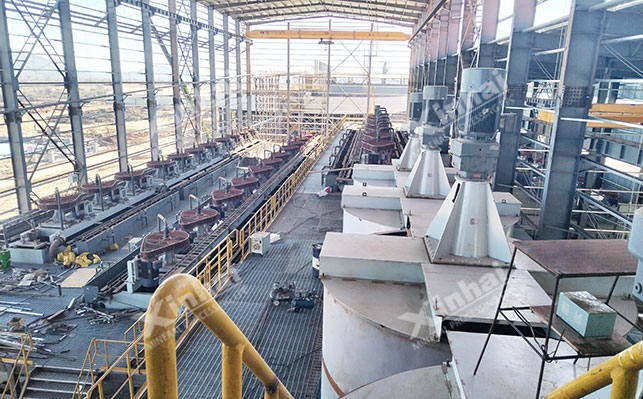
15311826613
Click to add WeChat80-90% of the world's phosphate rock is used for the production of phosphate fertilizers, feed additives, etc. It is not only used in agriculture, but also widely used in chemical, light industry, defense and other industrial fields. Therefore, the status of phosphate rock is very important. Due to the continuous development and utilization of phosphate resources in recent years, high-grade lithium ore resources have become increasingly scarce, and the utilization of low-grade phosphate resources has received more and more attention. Choosing a reasonable beneficiation method can greatly improve the efficiency of beneficiation. The following will introduce you to several phosphorus selection processes, namely flotation, gravity separation, roasting digestion and organic acid leaching.

Phosphate ore flotation process can be divided into positive flotation, reverse flotation, positive-reverse flotation, and reverse-positive flotation according to the order of flotation.
Positive flotation is direct flotation, which is usually carried out in alkaline slurry. Phosphorus minerals are enriched in foam by suppressing gangue minerals.
Positive flotation can be used to treat calcic silicate collophane, because of its fine particle size and large difference in floatability with gangue minerals, a reasonable reagent system can effectively separate gangue minerals from collophanite.
Positive flotation can also be used to treat magmatic apatite, because the phosphate minerals in the ore are characterized by complete and coarse crystals. Fatty acid collectors are used and the difference in surface properties with gangue minerals is used to sort the fine-grained sedimentary calcic silicate phosphate ore. As for the phosphate minerals, inhibitors are used to increase the difference in floatability with gangue minerals, and then fatty acid collectors are used for recovery.
Positive flotation has a simple process flow and is widely used in ore dressing plants. Since the floatability difference between magnesium oxide, carbonate and collophanite is small, positive flotation is suitable for phosphate ores with relatively low magnesium oxide and carbonate content.
Reverse flotation is to first suppress the phosphate ore and leave the carbonate substances at the bottom of the tank. This process is suitable for treating collophanite rich in magnesium gangue minerals, especially sedimentary magnesium phosphorite. When the reverse flotation process treats high-grade sedimentary calcium phosphorite, it can effectively separate the phosphate minerals and calcium carbonate gangue minerals in the ore. The floatability of phosphate minerals is similar to that of calcium carbonate minerals. Sulfuric acid or phosphoric acid is used to suppress the floating of phosphate minerals, and fatty acid reagents are used to float calcium carbonate minerals, and the phosphate minerals remain in the flotation tank. A typical example of the application of reverse flotation is the separation of collophanite and dolomite. Under the condition that the slurry is weakly acidic, fatty acids are used as collectors to separate dolomite and purify collophanite.
The properties of collophanite in nature are complex and changeable. Using direct flotation and reverse flotation alone will bring some problems. For example, it is difficult to obtain products by direct flotation, while the mineral particle size obtained by reverse flotation is fine, which is not convenient for transportation and subsequent treatment. Therefore, when necessary, it is necessary to use a combined direct and reverse flotation process to treat collophanite, such as direct and reverse, reverse, double reverse, double direct process, etc.
Direct and reverse flotation and reverse flotation are suitable for the treatment of calcium carbonate-siliceous phosphorite, because the siliceous substances in this type of ore are closely associated with phosphate minerals. Phosphoric acid is used as an inhibitor of phosphate minerals, and then fatty acids are used to remove carbonate minerals first. Water glass is used as an inhibitor to inhibit the floating of siliceous substances, and fatty acids are used to recover phosphate minerals.
Flotation is sometimes combined with magnetic separation to process phosphate ore containing magnetic minerals such as iron and titanium, but it is rarely used in actual applications.
The key to heavy medium separation is the difference in specific gravity of different minerals. Different density differences can separate minerals. This is a physical separation method. Low-grade phosphate ore can be pre-excluded by this method to improve the efficiency of subsequent separation processes. The gravity separation process has the characteristics of fast separation speed and no pollution, and is widely used in mineral processing plants. The gravity separation method is mainly used for the separation of calcareous and siliceous phosphate ores. Since the density of gangue minerals such as calcite, dolomite, and quartz in the ore is close to that of apatite minerals, the heavy medium method is often used in actual production.
Roasting and digestion method belongs to thermochemical mineral selection, which is to roast phosphate ore to decompose the carbonate impurities contained in it, and then remove them after scrubbing. Roasting and digestion method is mainly used for phosphate ore with high carbonate content and low silicon content, but this method strictly requires that the SiO2 content in phosphate ore is less than 5%.
For carbonate minerals with extremely fine embedded particle size, strong acid or weak acid can be used to leach the colloidal phosphorite in it, but the acid treatment also has defects. Strong acid will dissolve some useful minerals and reduce the recovery rate of phosphate concentrate. Weak acid will greatly increase the consumption of acid and increase production costs.
The above is a brief introduction to phosphate ore beneficiation technology. Different technologies are applied to different types of ores. Reasonable beneficiation technology will improve beneficiation efficiency and the recovery rate and quality of concentrate. Xinhai Mining can provide you with phosphate ore dressing technology, equipment and other full industry chain services, welcome to consult.